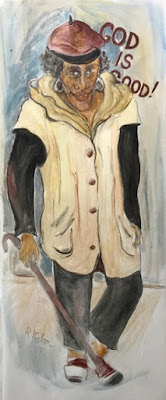I’m a notorious armchair
traveler. This is an expression I haven’t heard used much nowadays. At one time
it was used to describe someone who did his or her traveling through books –
there were lots of travel books when I was young - in the comfort of their own
home. Today, everyone I know is flying off to somewhere grand and exotic.
“Morocco?” “Bosnia?” “You haven’t been to the Carpathians? “ No, and neither do
I intend to go. I am perfectly happy traveling in my head, or if I need to get
out, within a twenty mile ratio of home. If I’m going to get an upset stomach,
I’d prefer to be close to familiar facilities.
 |
In The Bardo
Diptych 66”x86”. Oil, charcoal and collage on canvas
|
I come by my stay-at-home
genes honestly. My parents came to New York as teenagers in the early 1900s and
never budged. Why should they? New York had everything they could ever want in
terms of culture and ethnic diversity. There were Greek neighborhoods, Italian
neighborhoods, Chinese neighborhoods. Food shops, restaurants, clothing stores.
Maybe the Metropolitan Opera wasn’t equal to La Scala (although it probably
was), or the art museums the size of the Louvre, but they were more than enough
to amply fill their cultural requirements. My sweet father had an extensive
library of travel books, most written in the early 1900s when the world wasn’t
McDonalized. I’ve kept a few. At night, he would sit in his comfortable
armchair, next to out cabinet radio, listen to WQXR (the classical music
station), get a book (with photos) and travel (safely) in his head.
After college, most of my
friends set off on travels. Because I was needed at home to take care of my
parents (I was an “only” child with elderly, unwell parents), I had a one-hour
travel radius and could only go where I could be reached quickly in an
emergency. Somehow, I don’t remember being envious of my wandering friends. I
was studying Art History in graduate school and it seemed to me that a version
(maybe not as grand) of everything I would have seen in Europe, was within my
one hour time frame. So the Catskills weren’t the Alps and Coney Island not the
Riviera; I didn’t feel deprived.
 |
Heaven on Earth
Charcoal and oil on canvas
Center panel. 72” 44” |
After marrying, I had three
children in five years, and since going to the supermarket with them was a
herculaean effort, travel to foreign places was definitely out of the
question. When we moved to Stamford 55
years ago (only temporarily, we thought) we discovered there was no end to
interesting local places to take them to and they did not grow up culturally
deprived. My husband, also a non-traveler, preferred his garden to any place in
the world. He had served in the South
Pacific during World Was II and when he discovered that the women of the island
he was stationed on bore no resemblance to those painted by Gauguin, he lost
interest in exotic places. When two of our children moved to California, we did
get out and about on the West Coast, visiting the Redwoods, the Pacific
Northwest, San Franscisco, but the New York Botanical Gardens are 30 minutes
from our house and, except for the joy of seeing our children, we would have
been just as happy going there.
Nowadays, given my “advanced”
years, I definitely prefer to travel in my head. There’s enough stored there to
keep me visually occupied, in fact, I’m never going to get around to using the
imagery that’s already on file. I know that many, if not most, of my readers
love to travel, and I’m not being critical of them.
À chacun son goût (See, I even speak
French.)
Renee Kahn





